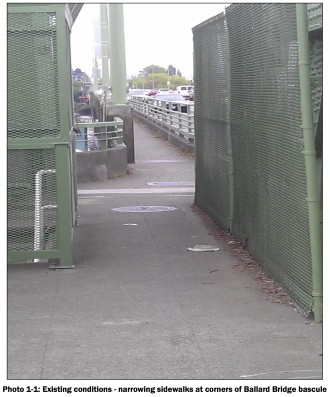
When it comes to major infrastructure barriers to cycling in Seattle, there are a select few that really stand out from the rest, such as the north section of Rainier Ave, the 520 Bridge and the Ballard Bridge. There are plenty of other big barriers, but these are the egregiously-awful ones holding back a flood of potential bicycle trips.
The Ballard Bridge is awful both for people walking and people biking. The sidewalks are barely wide enough for just one person to use, and if you have a walker or a wheelchair, well, the city owes you an apology. A low barrier separating the sidewalks from moving traffic feels more like a tripping hazard than a protective barrier, and it’s not hard to imagine yourself tumbling over it and landing in front of a fast-moving freight truck. If a second person uses the sidewalk while you are there, things can get uncomfortable and potentially dangerous fast (see photo above).
Fixing the Ballard Bridge is noted as a high priority in both the Bike and Pedestrian Master Plans. In a survey leading up to the 2007 Bike Master Plan, respondents listed the Ballard Bridge as the most requested bike facility upgrade.
For people who have been pushing to get city action on improving the Ballard Bridge for years (decades?), it is easy to feel like the city is no closer to a solution than it was in 2007 when the first Bike Master Plan recommended building a new bike/walk bridge next to the historic and people-hostile 15th Ave bridge. The city’s newest study looks at options for widening the existing sidewalks to make them more comfortable for people walking and biking, but the result does not provide a clear path forward.
The Ballard Bridge Sidewalk Widening Concept Study looks at three potential ways the existing sidewalks could be improved and tries to make a quality cost estimate for each. The good news is that most of the sidewalk segments can feasibly be widened. The bad news is that it will not come cheap, and no option would include widening of the bascule draw bridge section.
The study also looks at a high-quality trail connection at the south end of the Ballard Bridge to link to the Ship Canal Trail, which we will cover in a follow-up post (so stay tuned). That project also comes at a price. It turns out, if you build a major structure with only the movement of cars in mind, retrofitting it later to work for people is not cheap.
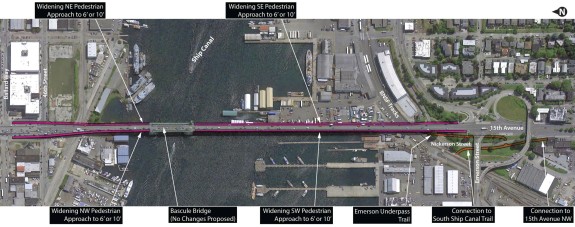 Three options for improving the sidewalks were analyzed:
Three options for improving the sidewalks were analyzed:
- Alternative 1 would essentially involve altering the concrete pillars that jut out into the sidewalk to effectively add another foot of usable width. This option would also include a railing between traffic and the sidewalk. This would cost somewhere between $21.8 – $35.8 million.
- Alternative 2 has two different options: Widening the sidewalks to six feet each and widening them to ten feet each. Because of structural work needed to make each option work and the need to redesign roadways adjacent to each approach, the six-foot option could cost between $25.6 – $39-6 million. The ten-foot option would be $33.9 – $47.9 million. The city could also do a ten-foot sidewalk on just one side for $20.2 – $34.2 million.
- Alternative 3 would just add a railing between motor vehicle traffic and the sidewalks for $3.2 million, but would not add any width to the sidewalks.
And again, no option would change the skinny sidewalks on the bascule section of the bridge. Here’s a more specific cost breakdown for each alternative:
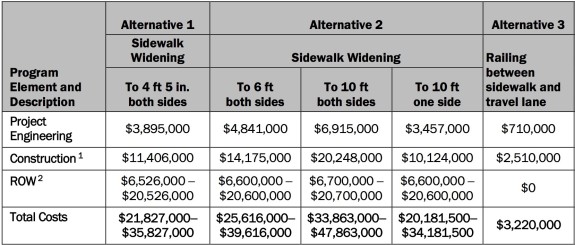 Alternative 1 analysis suggests that it’s not really worth trying to modify the existing sidewalk. Something like $30 million just to get dramatically sub-standard sidewalks less than four and a half feet wide? That does not seem worth the investment, as the study itself notes by saying, “It was determined that this nominal increase in width was relatively ineffective.”
Alternative 1 analysis suggests that it’s not really worth trying to modify the existing sidewalk. Something like $30 million just to get dramatically sub-standard sidewalks less than four and a half feet wide? That does not seem worth the investment, as the study itself notes by saying, “It was determined that this nominal increase in width was relatively ineffective.”
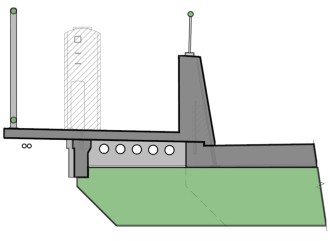
Likewise, the six-foot option in Alternative 2 seems like a poor investment. Six feet is simply not wide enough for two-way multi-use travel (accessible walking and biking). Sure, it would feel a mile wide to people who use the bridge today, but it’s not good enough to justify more than $30 million.
Ten feet is still below the 12-foot standard for multi-use trails, but it is on par with some other trails around town. This should be viewed as the only viable widening option studied, since the others would be essentially failing facilities the day they open.
One challenge for the ten-foot sidewalk options is that the now-wider sidewalks would hang over the edge of the roadway, interfering with truck clearance heights on the roads adjacent to the approaches. Those roads would need to be redesigned and in some cases right of way may need to be purchased.
A lower-cost option would include a ten-foot sidewalk on only one side of the bridge (probably the west side), cutting the project total down as low as $20.2 million. When combined with a potential trail connection at the south end of the bridge, this option could make sense, but it would hardly be an investment in future growth in bicycle traffic.
Alternative 4
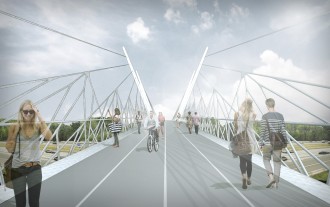
There are still two key options for addressing the Ballard Bridge issue that were not studied: Building an all-new bike/walk bridge nearby (what I’ll call Alternative 4) and an on-street redesign option (what I’ll call Alternative 5).
There is no doubt that building an all-new biking and walking bridge would be very expensive. But now that we know it would cost somewhere between $20 – $48 million just to get the bridge to more usable but still substandard sidewalk widths, the cost of an all-new bridge might not seem so expensive.
Unfortunately, we don’t have a good cost estimate for a new bridge option. The Northgate bike/walk bridge crossing I-5 is estimated to cost $25 million, but that bridge does not cross water and does not have to provide adequate clearance for maritime travel (which means it either needs to be super tall or have a draw bridge section of some kind). I am not an engineer, but it’s a safe bet that those elements would add quite a bit to the price tag. But would it cost much more than $48 million, the high-end estimate for the ten-foot sidewalk option?
Some in the city have also been trying to fund a Ship Canal Crossing study for a future high-capacity transit option to Ballard. It is possible that a transit crossing could include a biking and walking element, but it’s also possible that the most viable crossing would be a subway tunnel under the Ship Canal or that the best crossing ends up too far from the Ballard Bridge to really solve the problem.
Alternative 5

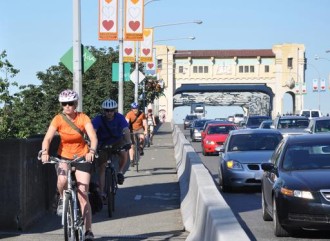
On the far opposite end of the project spectrum is a very low-cost bridge redesign option: Add a bike path to the bridge deck.
Vancouver did this to the fairly similar Burrard Street Bridge in 2009. That bridge did not have a safe space for cycling, and the sidewalks were much too skinny for both biking and walking. As plans to widen that bridge’s sidewalks saw cost estimates escalate beyond $60 million (Canadian), the city opted instead to repurpose one travel lane to create space for a two-way bike path. The project only cost $1.8 million (Canadian), which included evaluation studies. Those studies showed that vehicle travel times were not significantly impacted, but the number of people biking across the bridge skyrocketed.
So, with such a great example to draw from up north, would this work in Ballard?
Unfortunately, the recent study does not analyze this option, so there are no good traffic analyses to work from to know whether and how much such a project would impact traffic flow across the Ballard Bridge. Vehicle volumes are high (54,500 per day according to SDOT data), and both southbound and northbound directions can get packed in their respective peak travel hours (southbound in mornings, northbound in evenings). Today, the bridge deck is essentially 40 feet wide divided into four ten-foot lanes. It is a major freight corridor and carries a lot of buses.
In Alternative 5, we would follow Vancouver’s experience and create a bike path in one of the existing travel lanes. This would free up the sidewalks for people walking and create a much improved and much safer space for people biking, which would be protected from motor vehicles by a barrier of some kind (the Burrard Bridge project used a jersey barrier).
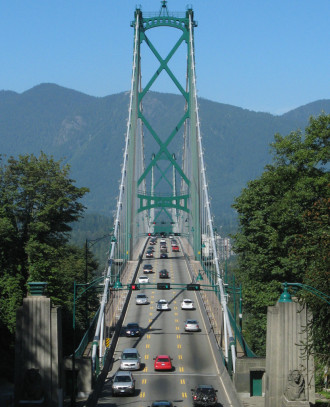
Traffic analysis would be needed to determine the best design option for the other three lanes. The two obvious options are two lanes southbound with one northbound or two lanes northbound with one southbound.
But a third option could possibly include a center lane that is reversible depending on the time of day (thanks to commenter Rodney Dwyer who suggested this in a previous post). So in the morning commute it would allow southbound travel, but would switch to northbound for the evening rush. I have no idea how plausible this concept would be since I cannot think of a non-freeway example in the Seattle area. But this design is used around the world, including in, you guessed it, Vancouver. The Lion’s Gate Bridge carries 60,000 – 70,000 vehicles per day, which is 5,000 – 15,000 more than the Ballard Bridge.
So Vancouver has two examples of bridges similar enough to the Ballard Bridge that we can learn from them. I say, let’s give it a try. The Burrard Bridge change was originally a pilot project so the city could see if it would work. It did work, so they kept it.
Let’s try it in Ballard. If it fails, we can go back to the drawing board and start preliminary design work for a new bike/walk bridge. But if it works, we could save tens of millions of dollars and improve safety and access for people walking across the Ballard Bridge in a much shorter timeframe.

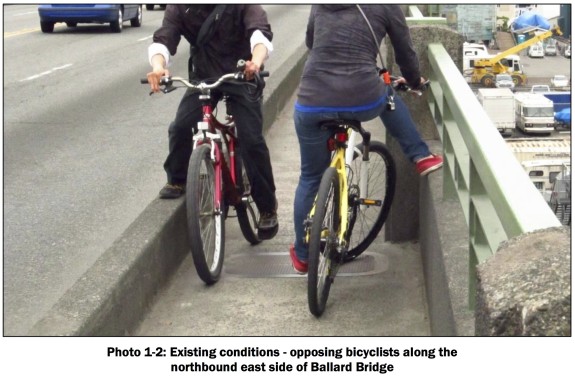


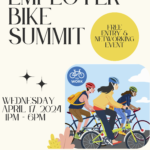






Comments
70 responses to “Study: Widening Ballard Bridge sidewalks possible, but it won’t be cheap (+ is there an easier way?)”
For Alternative 5, my (oft-faulty) memory suggests the Burrard Bridge setup for bicycles has been changed yet again. If believe the sidewalk on the north(ish) side is for pedestrians in both directions (east and west). An adjacent bike lane serves west(ish)bound bicyclists. Finally, the ex-sidewalk on the south side handles eastbound bicyclists. Someone else can jump in and tell me how far wrong I am, but it is no longer as pictured/described, albeit perhaps for the better.
Your description of the setup is correct, but it has been like that since Day One.
(Scratching head…) I’ve been going to Vancouver annually since 2003. In recent years especially, there have been shifts in lane and purpose (changing among pedestrians, bicycles, cars). I recall the right, westbound car lane becoming a bicycle lane, with the help of temporary (as a test/experiment) dividers twixt it and the adjacent car-traffic lane in maybe 2010 or so, and becoming permanent the following year. Prior to that, and possibly with some change in between, bicyclists and pedestrians shared the sidewalk. I don’t have anything specific close to hand to back that up, but walking across Burrard in 2003 vs. 2013 were radically different experiences. (I sure *hope* this ol’ brain isn’t failing!)
By Day One, I mean from the first day a regular traffic lane was reallocated to bikes. Before then, bikes and pedestrians shared the two sidewalks, bikes one-way and pedestrians two-way.
This past summer, the intersection at the south end of the bridge was completely redesigned to better accommodate all modes.
Re option 5: I have my doubts that peak traffic on the Ballard Bridge is directional enough that the counter-peak traffic wouldn’t be horribly backed up with just one lane… and I wouldn’t care very much about that if it wouldn’t be such a disaster for transit reliability and freight movement.
Maybe. It’s definitely worth studying, though. I bet traffic is pretty directional. Plus, the approaches have a lot of room to work with to get the merging done right.
Plus, remember, 15th is not a highway. It’s a city street, albeit a busy one. We just treat it like a highway, which is why it feels that way.
I’m curious about this too. What do traffic studies suggest relative to Option 5? Is peak traffic directional enough for this to work?
Option 5 is my option. They did not study it, so I can’t say for sure if it would work. But Vancouver’s Lion’s Gate bridge carries significantly more traffic every day than the Ballard Bridge, and it does so with three lanes (center lane reversible). So if it works there, I’d bet it would work here on a less busy bridge.
Does the Lion’s Gate have a drawbridge that opens for marine traffic? That’s where the biggest impacts occur for traffic at peak hours. I have a reverse commute (southbound on the bridge) in the evening when I drive, and I know if I leave work too late to cross by 6, a bridge opening can back traffic up to Market… And often on Leary as well.
Honestly, the parts of the bridge where it draws feel decently wide – granted, that’s in relation to the rest of the bridge. Anything that widens the scarier, narrow “trip hazard” parts would be an improvement I welcome. And improved links to the trail would be a plus!
Maybe we just need a new bridge? When the viaduct closes (though I’d love if we turn that into our own Highline park/bikeway), there will be increased car traffic on our arterials. Do we know what grade engineers have given the Ballard Bridge?
I’ll add OPTION 6. Build an above grade ped-bike pathway. This could be a bit like option 2 in that the pathways start at grade, perhaps on each side of the bridge, but ramp to 16′ (or whatever in needed for clearance below) by the time they reach the bascule area. In the bascule area, the pathways jog over to the center of the roadway, on top of the bascule.
For an existing and successful implementation of this, see the Williamsburg bridge between Manhattan and Queens.
That’s an interesting idea! Should be added into the planning mix.
How about Option 6, prioritize transit while accommodating bicycles — it would require some right of way work at both ends of the bridge, but make the reversible center lane bus-only, with queuing areas at each end of the bridge.
With rigorous traffic controls for the bus-only entrances, you could reverse direction every few minutes. Let through a platoon of northbound buses; give them to clear the bridge; let through a platoon of southbound buses. You’d eliminate a transit bottleneck, provide safe bicycle and pedestrian access, and greatly increase the passenger (not vehicles — people) capacity of the bridge.
Or make the curb lanes of the three reversible lanes bus lanes. So you’d have one general traffic lane in each direction all day, but the curb lane of the peak direction would be a bus lane (or bus and HOV 3+, maybe also freight?). That might be a more natural flow for buses serving curb lanes. Would also meet up nicely with existing or expanded bus lanes on 15th.
I’ve said it before but it’s worth repeating. Indeed it would be very nice to have any widening or extra pathing on the Ballard Bridge. However I think an immediate need is Alternative Three which simply puts a rail (on both sides) separating the paths and the traffic. I see it’s $3 million as compared to the other alternatives which is “cheap”. I would think the continuation of the railing on the top of the bridge would be cheaper than that but I’m not a highway engineer.
As far as the width which is non wheel chair friendly, awkward when 2 bikes pass are all negatives but the path now exists and is doable. It is not a speed trail but simply an point to point utility path. Right now most of the “encounters” with bicycle-bicycle, bicycle-pedestrian, pedestrian-pedestrian are amiable exchanges. No we don’t necessarily like it but we are willing to stop and help each on the crossing.
Please campaign for Alternative 3 and spend “years” getting approval for the other wonderful solutions. Alternative 3 will make the crossing 100% safer and is needed as soon as possible.
I don’t disagree with you there. If they go with a bike lane on the deck like in Alternative 5, then we could even skip the rail on that side and just put it on the other side without the bike lane to act as a buffer.
As another option for a cheap, stopgap solution, perhaps the sidewalks on the Ballard bridge should become one-way for people on bikes. That way, you at least avoid the problem where bikes cross each other in opposite directions.
Of course, posting one-way signs and getting people to actually obey them are different matters.
Amen! I second that vote.
Problem with forcing one-way is complicating perhaps the one place where salmoning (going the wrong way) is correct/needed due to traffic density on both entrances/exits. For example going North (I live in QA) it would really bother me if I have to cross 15th (or take the very gnarly underground path to cross) similarly going South to get to QA. (BTW I only go North from QA , I don’t want to climb QA hill to go home – I’ll take the Fremont bridge for milder hills home)
On the Ballard side dependent on where you approach it – to force a one way crossing would involve very heavy (trucks/buses also) traffic maneuvering.
Access is so bad to this bridge, that riding “wrong way” makes the best sense for some people. I never really mind when I come across a “wrong way” rider. Stop and pass. We both are stuck with a really crappy crossing that we have to deal with.
FYI, the Golden Gate Bridge has long had reversible center lanes. It’s a bit different (six lanes total, set up either as 3 and 3, 4 and 2, or with an empty “buffer” lane at night or during bad weather for safety), but it’s basically the same idea.
http://goldengatebridge.org/tolls_traffic/RoadwayConfig.php
Thanks! It’s an idea that could also maybe work on other bridges around town that are lacking proper bike access, like Fremont or Montlake…
I’m not sure why you say that a westside 10-foot path (in conjunction with a safe and comfortable connection to the Elliot Bay Trail) wouldn’t be a real improvement for future use. It seems like that would be a substantial improvement if paired with a few miles of protected bike lane on Gilman – a fully protected/off street route to downtown from North Seattle.
A reversible lane is a good idea assuming the traffic demands support it, but I imagine the political fight over that would make road diets look like a cakewalk, regardless of the actual merits of it.
A ten-foot path would absolutely be better at handling today’s bike and walk traffic, but what about five years from now? 10? 20?
When spending that kind of money, the city needs to be thinking long-term. Widening the sidewalk could be the most expensive bike and walk project in the city. For that level of investment, we need to be building for the bikes that are not yet on the road. A ten-foot path just isn’t that, especially one that has a pinch point in the middle of it (it’s pretty much impossible to widen the bascule sidewalks). I say we either go for the easy, low-cost surface route or go big for the new, properly wide bridge. Or both, in due time.
Not sure the reversible lane is entirely adequate for bus support in the non-peak direction. Bus drivers are frequently uncomfortable enough in the narrow lanes of this bridge that they straddle both lanes (similar to what they do on the Aurora Bridge). With this proposal the non-peak operators lose that option, so they should probably at least be consulted to determine how strictly necessary it would be.
That’s one issue I was curious about. Something planners would need to figure out in the design process. Maybe there’s a way to boost curb lanes to fit buses? I can’t say for sure.
Maybe the bike lane could be 8ft wide and each outside auto lane would be 11.
At nearly $50 mil, I doubt any retrofit of the existing bridge will ever happen, and likewise any new bike+ped span of similar length is likely to be exorbitant.
I’m pimping my own idea here, I realize, but I still think the best and only new crossing of the Ship Canal that could plausibly get built in the next decade, if every interest group started pulling for it is this one:
http://seattletransitblog.com/2013/04/12/a-better-ship-canal-crossing/
Build a new car+bike+ped bridge at 3rd Ave N/NW and turn the existing Fremont Bridge into a transit+bike+ped bridge. That would dramatically improve transit, bike and ped connectivity, and (depending on how transit-only you make the Fremont Bridge), maintain or increase the number of car lanes across the Ship Canal. No-one’s goose gets cooked by this, and every road user has a reason to like it.
By crossing at a narrow point, the cost and complexity are dramatically reduced compared to any work in Salmon Bay. I grant that it doesn’t solve the problem of getting to or through Interbay on a bike, but to destinations in SLU, near Westlake, most of Belltown and Queen Anne it’s a wash or even better. Plus, within a couple of years, we will have an almost-complete low-stress route via Westlake. If we blow a wad on the Ballard bridge, we still have to fix the rest of Interbay — which should happen, but will cost still more money.
Your points have merit but I don’t think we will see any new private vehicle bridges being built across the canal. First, the feeder routes can’t handle the traffic, in particular Nickerson St. Second, SPU will put up a fight you haven’t even imagined possible. They own all the property on both sides of Nickerson and both sides of 3rd in the vicinity.
Putting a transit and bike-ped crossing at 3rd NW might be supportable though that still doesn’t solve the Ballard Bridge problem.
Transit doesn’t need to cross at 3rd; transit needs to cross at Fremont, to minimize the walking distance for passengers headed to the dense core of that neighborhood. The vast majority of drivers going through Fremont are just passing through, and a bypass will work fine for them.
I was thinking of this as well. It would certainly be a step in the right direction, but I don’t think it solves the problem. For someone in Ballard who wants to go the west side of downtown, he or she has a couple choices:
1) Tough it out and go over the Ballard Bridge.
2) Go all the way around via the Fremont Bridge. Other than the distance, this is a pretty good route (bike path most of the way).
Your solution would cut the “detour” distance about in half. That would be really nice, but not a complete solution. Your point about the crossing distance is a good one. I bring that up in a separate comment (and I don’t want to hijack the thread).
Every argument of the form “we shouldn’t spend so much money on a not very nice solution when bike traffic in 10 years may be much higher” has a mirror image argument of the form “we shouldn’t spend money reducing car lanes that already exist when in a few years time we’ll be desperate for them as the city grows”
This also means that using one lane of the bridge for cycling/walking might, over time, backfire badly.
My personal bet is that nothing beyond a better railing will get funded in the next 20 years.
By the way, I find the argument “It’s not a highway, we just treat it that way” to be unsound. The key pathways used to travel through any area are key pathways, regardless of how they are marked on a map. Fauntleroy is “just a city street” but it’s one of only two effective pathways to Vashon island – so it is in a very real sense a highway.
Alternative, uh, 7 …
Bicycles and pedestrians require less head room that trucks (clearly not 14′) – could a wider pathway to support such uses fit *under* the bridge? (Uh, right-of-way height problems below, yes?) Also, would have to be tall enough to allow maintence and aid equipment to traverse the whole route.
First, in the top photo why isn’t the person on the red bike riding WITH the flow of traffic instead of against it? A little common sense can go a long ways.
Second, improving the Ballard bridge just seems like a waste. The bridge is now inadequate for just about everything. Build a new bridge and be done with it. I’ll never understand why any infrastructure project in this town seems to take forever – and multiple elections – to get done. Build a a bridge wide enough to handle future traffic growth, provide access for all users and can accommodate future rail transit (if and when the idiot voters of this town finally decide to grow up and become a real city!) Personally, I keep hoping we have a serious quake that takes out the Ballard and Montlake bridges to finally force the city to actually do something beyond endless debates and elections.
The bad news is that the Ballard Bridge was recently earthquake-retrofitted and is in fine seismic shape. The most likely new crossing of Salmon Bay specifically (as distinct from the Ship Canal over all) would be a new 70′ light rail bridge, which could include a trail.
Oh no, so that might have been a good time to install some cycling infrastructure when they’re doing the seismic thing already.
Lost opportunity.
Tom Wrote: “A low barrier separating the sidewalks from moving traffic feels more like a tripping hazard than a protective barrier, and it’s not hard to imagine yourself tumbling over it and landing in front of a fast-moving freight truck.”
This!
Berger ABAM wrote (in report linked to by SDOT at link above)
“Alternative 3
SDOT concluded that this alternative is technically feasible. Installing the railing may increase the comfort of people traveling along the sidewalk”
May ? I think that is F’ing absolutely understating it. Well, sure, a railing may make the sidewalk fell even more constrained, but given the choice between a stationary railing 6″ away and a truck going 40mph, 18″ away, I’ll take the former (actually, I lie, I’ll likely still ride around to Fremont)
One problem with any of these options is that once one gets across the bridge one is still on 15th Ave NW (or, if Southbound, possibly lying dead at Emerson). Since I work in Interbay I consider 15th a necessary evil, but evil nonetheless.
BTW, one of the proposals for an Emerson underpass is nearly $18M, add that to any of the widening options and you’ve got a total non-starter. Especially considering Berger ABAM wrote: “In evaluating the alternatives, the remaining useful service life of the structure should be considered. Bridges built in the 1930’s were designed to last 60 years. The approaches to the Ballard Bridge are now 73 years old. Based on their age alone, the bridge’s approaches might be considered to be at the end of their service life. However, the bascule portion and steel approaches are in good condition and are expected to remain in service for at least 25 to 30 more years.”
As far as taking a lane for bikes, does anybody know how many bicyclists use the Ballard bridge now? Even if all the bicyclists who uses the Fremont bridge (probably less than 4000/day year around average) moved over to the Ballard bridge, that would be taking 25% of the road for maybe 7% of the vehicles, considering the bus traffic probably much less than 7% of the people, and maybe 0.001% of the gross tonnage of freight. The Seattle Times commenters would just love that!
I imagine the best option is to use the Fremont bridge until the Ballard bridge falls down, then lobby for doing it right the next time.
It is great to debate and fantasize what may or probably won’t happen to provide wider and safer lanes on the Ballard Bridge in the distant future. But the reality is the Ballard Bridge sucks right now, and needs to be improved right now. There are MANY low cost improvements that can and should be done now to make the Ballard Bridge better for biking. It is not all about the width of the sidewalks. I was amused to read the SDOT report, and see that the pictures were carefully taken to not show the absolutely horrible condition of the existing pavement of the sidewalks.
This is so classic Seattle, isn’t it? The Ballard Bridge sucks, so let’s spend our money studying it, and in the meantime do nothing to improve the situation.
The southwest sidewalk is heaved and potholed beyond belief right before the double black diamond merge of death at Emerson St. The southeast sidewalk on the approach is potholed beyond belief. Both of these sections are relatively short, but very rough and very dangerous. SDOT – FIX THEM NOW.
There is not a good connection to the bridge from the Ship Canal Trail. But there is plenty of room on W Nickerson St. – SDOT PUT IN A BIKE LANE.
In 2009, SDOT estimated that an underpass of Emerson St. to bypass the merge of death would cost $900,000. SDOT, BUILD IT. And speaking of the merge of death, why does the speed limit change from 30MPH to 40 MPH right BEFORE the merge of death?
Every single day as I ride up the bridge approach southbound on the west side, a car blows through the stop sign at NW Ballard Way and nearly hits me. SDOT, REDESIGN THIS INTERSECTION SO IT IS SAFE.
Yeah, it would be great to get some wider lanes. We all know that if that happens, it would be in the far, far distant future. We all know that if there is a proposal to take a lane on the bridge for a bike lane that the same NIMBYs that have blocked the Missing Link (now in their second decade of obstructionism) will do the same thing again. But there are many, many things that could be done now to make the Ballard Bridge better.
SDOT needs to stop wasting time and improve the Ballard Bridge now. They have done NOTHING in the years since the citizens of Seattle identified it as the worst place to ride a bike.
This comment is so great. But why should SDOT go outside and work in the sun/cold/heat/rain when they can whip up fancy looking reports in their climate controlled offices?
“The southwest sidewalk is heaved and potholed beyond belief right before the double black diamond merge of death at Emerson St. The southeast sidewalk on the approach is potholed beyond belief. Both of these sections are relatively short, but very rough and very dangerous. SDOT – FIX THEM NOW.”
I’m guessing one of these nights I’m going to have a few too many at Peddler and take a sledgehammer to the curb that keeps cyclists from going straight and throws them directly into traffic. No cost to the city.
If I have a few more drinks I’ll take some quick pour concrete and fill in the numerous pot-holes that have provided countless punctures and a great place for water to collect that ends up drenching you when cars drive through them. No cost to the city.
So if you see a guy with a sledge hammer and a bag of concrete at Peddler make sure to buy him a beer :-)
Drinks are on me :)
And a few more thoughts.
Really, the most dangerous and unsafe part of the Ballard Bridge are the pilasters that jut into the sidewalk. I would have to say the merge of death comes in second.
I have seen two cyclists catch their handlebars on the sidewalk pilaster, and then fall over the curb into the traffic lane. Both times I thought to myself as I watched from behind that they would be dead. Fortunately neither of them was hit. Terry McMacken wasn’t so fortunate, and died as a result of injuries suffered from crashing on the Ballard Bridge in a similar fashion.
Regarding the “construction cost estimates”. The actual construction cost for the 10’ wide sidewalks on both sides is $26 mil, with an additional $20mil added on for right of way “ acquisition, construction easements and business relocation and re-establishment costs”. I’ve looked hard at the bridge, and can’t imagine any business needing to relocate due to adding 6’ to each side of the bridge. Most of it seems to be because of the small, useless side streets on the north end flanking the bridge. Seriously, if these streets were eliminated life would go on unchanged, and actually safety would improve. In fact, they should be eliminated anyway due to their unsafe intersections, and made to be bicycle access to the Burke Gilman Trail from the Ballard Bridge.
There’s an idea! I also wonder what the ROW acquisition costs for a parallel trail would be. I imagine a lot.
If the city can figure out how to knock off half the cost by avoiding ROW issues, that would be interesting. Would bring the project a little closer to realistic.
And yes, those “pilasters” are awful. I ran into one once trying to get over for someone coming the opposite direction. It hurt, but luckily I didn’t fall into the street or anything.
Supposing Ballard light rail goes with an Interbay option and a tunnel under the canal, could a bike path be put through the tunnel? We have the Mt Baker bike tunnel which which works great, and piggybacking a similar idea onto another project that stands a good chance of getting built built anyway would be much easier and cheaper.
Or, if rejigging the Ballard bridge is preferable, perhaps the connection to the ship canal trail can also include the planned connection from the ship canal trail to Thorndyke/16th under W Emerson St, a gap of roughly 560 to 666ft. Two birds with one stone and the increased utility should mean more support too.
If light rail goes through Interbay I really doubt that they will build a tunnel. The big advantage of an Interbay route is that it is fairly cheap, and part of the savings is because a bridge (even a 70′ high retractable bridge) is much cheaper than a tunnel. Besides, riding a high bridge over the western end of the ship canal would also be a lot more popular for riders than a tunnel.
Oops, I didn’t mean to ignore the bridge option. You’re right, it would be much nicer than a concrete hole.
I want to add that getting splashed by vehicles while crossing the bridge on that tiny, ultra constrained afterthought they call a sidewalk when it’s raining is an experierience that truly demonstrates the indignity suffered by those who use their legs to travel.
Did I miss it, or was it not addressed: a new bicycle pedestrian bridge would have to accommodate shipping traffic. This means either a new drawbridge (VERY expensive) or a VERY tall bridge to allow ships to pass underneath. The latter option would be prohibitively steep/tall for pedestrians and many (all?) cyclists.
It seems like it should be possible to retrofit the existing bridge somehow for FAR less than it would cost to build an new additional bridge for peds and bikes.
Of course, if money were no object, a new (draw) bridge for peds and bikes would be ideal. If somehow the existing bridges sidewalk does get widened, I’d bet a limb that it’ll still be narrow and sub-optimal.
It might be possible to suspend a bike lane under the cantilevers. Take a look at this photo:
http://upload.wikimedia.org/wikipedia/commons/3/3d/Ballard_Bridge_from_Seattle_Maritime_Academy_01.jpg
– There’s plenty of clearance between the bottom of the girders and the underside of the decking.
– At the pilasters, the paths would have to veer outwards and go around.
– For the bascule, the paths would need to have a slight ramp to meet the boat clearance at the center of the span.
– The bascule part has much less cantilever, making it more practical to extend outwards rather than under.
Although I no longer commute by bike over the Ship Canal bridges, I did for years (Fremont and University Bridge). I’d like to see this Ballard Bridge project built and would gladly give up projects like Fauntleroy (in my neck of the woods) to see this project done right.
You have to be careful in analyzing the cost estimates the city represents, because I would not be surprised if some of the costs for “widening” the bridge for bicycles are really upgrades for the entire bridge and benefit autos too. For example, I suspect this project would require upgrading to current earthquake design standards – which would not solely benefit cyclists and pedestrians. I suspect a good portion of the costs reported are really for the earthquake upgrades.
The new (separate) bridge concept sounds good when I put on my urban design hat – better than scabbing on some monstrosity to the side of the existing bridge, but not necessarily so good for cyclists or pedestrians due to the grade they would have to climb to to provide sufficient clearance underneath for waterborne traffic. The length of a separate bike/ped bridge would be longer too (due to the increased height) and access from the neighborhoods north and south of the bridge might be curtailed.
I can’t imagine a draw bridge option flying given the cost and the potential for ongoing operations costs for maintenance (including staffing an operator). There are many untended draw bridges in Europe, but I do not think out legal system would allow the city or a design firm to pursue such an option.
I wonder if the current bridge operator could do both.
Worth mentioning is that a pedestrian/bike bridge does not have to be built to interface with streets the way that an automobile bridge does. Every car bridge is essentially an extension of the roadway on both ends. The roadway approaching the bridge is straight. In some cases for a very long ways (e. g. the Ballard Bridge).
But a pedestrian/bike bridge doesn’t have to do that. This gives the bridge designer a lot more leeway. For example, consider a bridge from about 22nd Ave W in Magnolia, to about 20th Ave. NW in Ballard. Such a bridge would not be perpendicular, nor even connecting to the nearest set of streets, but would simply cross the water at an angle that minimizes the bridge distance. On either side there is plenty of room to curve the pathway and thus avoid sharp turns (sharp turns, by the way, that are pretty common elsewhere).
I’m not sure what the minimum height of a bridge like that would be. Fremont is the lowest one on the ship canal, at thirty feet. I’m guessing that would be the goal. That means you would need to build it up a bit on both ends, but I don’t think it would need a very long approach.
I would be curious as to the cost of such a bridge. Connecting the heart of Ballard with Fisherman’s Terminal would be nice for those just trying to get to work, but also great for tourists and locals who want to visit a couple of great attractions.
[…] Study: Widening Ballard Bridge sidewalks possible, but it won’t be cheap (+ is there an easier way… […]
I ride the Ballard Bridge everyday. First thing that struck me for this article was the absolutely ridiculous cost for the railings. The city erected railings for a short distance on either side of the drawspan about 10 years ago after a Jeep flipped up and off the bridge. After looking at that railing yesterday, it really seems like extending that railing for the entire bridge should be able to be done immediately ($700K for engineering some railing and bolts? Really?). That kind of calls into question whether this report’s cost estimates are just absurdly high to kill any type of action. Also, I have to agree that options such as hanging a new sidewalk off the bridge but lower than the roadway sure seems like it should have been considered. The drawspan would likely remain the same way it is, but that’s already the most comfortable part of the sidewalk now and probably o.k. to live with until major upgrades to the span occur. For almost the entire bridge, the clearance is extremely high, so interference with roadways below would not be an issue. For the short distance on the north end where clearance could be an issue, maybe that’s where the sidewalk comes back up to roadway level, but it would be a pretty short distance, and therefore should be much cheaper. Hey, I’ll go ahead and estimate that it would probably be $20 million cheaper!
Re: the Merge of Death, aka the southbound ped/bike exit, a cheap-ish stop-gap would be to strengthen the already-existing ‘exiting bikes have right-of-way’ sign with 1) a big bright green bike lane swath on the pavement, and cyclist-activated blinking lights that are attached to both the right-of-way sign and to the exit itself.
I like the blinking lights idea. That works really well for Lake City pedestrians (there is no waiting for a walk signal, but when a pedestrian tries to approaches the crosswalk, the lights flash).
Yes, add improved signs to the very inexpensive but very important list of upgrades that are needed to improve the safety for all users of the Ballard Bridge. The current two signs instructing cars to yield to bikes are both terrible. The first sign is confusing and implies that only turning vehicles need to yield to bikes, and the second one is a total afterthought, very small and hung low at the merge.
A very large and very strong and clear YIELD TO BICYCLES ENTERING ROADWAY sign needs to be added, and then a stop line with STOP HERE FOR BICYCLES ENTERING ROADWAY sign. Flashing lights activated by an oncoming cyclist would be an added bonus. Do I need to mention that everyday most cars just blow by me and ignore these signs, despite clear signals from me that I am entering/turning onto the roadway.
I would encourage all cyclists to use a left turn sign prior to entering this “merge”. I see many riders just ride up and wait. As a driver (pretty rare these days), I’m not really sure what you are doing if you don’t signal.
Another unusual idea: A small passenger ferry. When I say small, I mean tiny (smaller than anything in our fleet). This boatfor example, can carry 18 people and is probably more than adequate. There would be no schedule, but rather a button to press on each end. If you arrive on the end where the boat is, you simply ask the skipper to take you to the other side. Otherwise, you press the button (you could probably just waive a flag).
This gives the city plenty of flexibility when it comes to the actual location (unlike a bridge). You simply need a path to the dock. I’m not sure of an ideal location. From a tourist standpoint, you would probably want to connect the main part of Ballard with the Fisherman’s Terminal. I think 20th NW (Dock Place) would work well, but you would need to add a traffic light and clean up the streets a bit. If there are issues there (with private land) then you could put it at 14th NW, where there is already a boat ramp and dock (http://goo.gl/maps/3Ndt4).
Riding a ferry would be significantly slower than a similar bridge crossing, but for people on the waterfront bike paths, there is no similar bridge crossing. The Ballard Bridge is terrible, and even if we spent the full amount (for ten foot pathways on both sides) it would still be really bad. It would still require going “up and around”, which means a bit of altitude gain and distance. This is no big deal to most riders, but the casual rider — the rider most likely to stick to paths like the Burke Gilman — this is a pain. From a walking standpoint, it will still be really noisy and unpleasant. Going around via the Fremont Bridge or the locks is OK, but a big detour.
A boat, even a very slow boat, would be reasonably fast, and a much more pleasant way to cross. Paying for a ferry would require a subsidy by the city. But unlike most ferries, you wouldn’t need a full crew. One person could do it; but if you really want, you could have two employees. A new drawbridge would need a new operator anyway, so your maintenance costs are probably similar. Your capital costs, on the other hand, would be much, much cheaper.
A rowboat that’s big enough to carry 4 people would probably do the trick. It’s not like there are currently that many bicyclists/minute crossing this bridge.
I agree, and I think that really shows the scale of this thing.
But a small motor boat would be fine. For the cost of the railing you could get a medium size boat (enough for a dozen people), fix up the docks, add striping and still have enough money to pay for the first couple years of the crew, gas and maintenance. That’s for the cost of the railing. For the cost of a widening, you could probably do the same work, get a bigger boat (a million bucks will buy a nice boat) and pay for the crew and maintenance for ten years.
By then we will probably want to build another bridge, whether a light rail bridge or a vehicle bridge (as Bruce suggested above). We just have to make sure such a bridge can work for bikes.
Great idea but you’re not taking it quite far enough. What we need here is a small fleet of robot (self-driving) ferry boats. The city could contract with Google or maybe Amazon-would be a great low-risk small-scale demonstration project for both the city and whoever we could get to sponsor it :-)
If you’re going to go with the ferry idea, you may as well just tell people to ride the bus that already stops at each end of the bridge, similar to what is done for the 520 bridge.
The problem with that idea is that the capacity of the bus limits the bike throughput to a mere 12 people per hour (4 buses per hour times 3 bikes per bus). If the existing sidewalk is already carrying 12 bikes per hour, a decent sidewalk would probably carry many more than that.
So many interesting ideas here re the Ballard bridge. I don’t think anybody can accuse folks of not exploring every possible angle for making one bridge do more.
It’s worth remembering that decades ago– when the Ballard bridge and others were being built– this country had much less wealth than it does today. From the perspective of the sheer amount of money now washing about in this country it should be a snap to build more bridges today. Unfortunately, expectations of social responsibility have changed since the Ballard bridge was constructed; in 1917 the effective taxation for the very rich in the United States much higher, 67% for the most successful people. People who were exceptionally successful with adapting their citizenship to personal enrichment were expected to kick more money back into the kitty, making the country the better for being able to afford such things as bridges.
The fact that we’re willing to pretend that we can’t afford even $3 million to add railings separating traffic from pedestrians and cyclists on the Ballard bridge is a bit of a metaphor for how degenerate we’ve allowed our society to become.
There’s no solution for making Seattle a better place to live if we continue to insist on pretending we’re poor.
That’s a problem that the U.S. has to fix. The belief that taxes should be low. It’s an idea that got sold to you in the ’80s and it only benefits the wealthy.
Most other countries in the world understand that taxes make a place better.
Look at the budget for a single crappy TV movie and that would buy you a skookum hang-off-the-side path on this bridge.
Places without taxes have streets that are falling apart and high crime and poverty. Places with taxes are kept up and the general populace are educated and civil.
“Places without taxes have streets that are falling apart and high crime and poverty. Places with taxes are kept up and the general populace are educated and civil.”
Succinctly put, thank you.
“…Places with taxes are kept up and the general populace are educated and civil.”
I moved from Vashon Island to Western Mass 3 years ago.
They are educated, and most of ’em, most of the time, are civil, but ‘kept up’? ::snort:: Ditto for Connecticut.
Lovely idea tho.
[…] studied several options for cantilevering widened paths, priced in the range of $20-30 million. Seattle Bike Blog has suggested a much more elegant road diet solution. Further study is […]
[…] studied several options for cantilevering widened paths, priced in the range of $20-30 million. Seattle Bike Blog has suggested a much more elegant road diet solution. Further study is […]
[…] As we reported previously, the city quietly released a report last year outlining some rough cost estimates for various sidewalk-widening options. None of the options stand out as a slam dunk as studied. The cheaper options are not all that cheap and would provide only small improvements. The more complete options were estimated to cost a gigantic sum ($20-48 million depending on various factors and options). But the report is at least a starting point to finding solutions. […]
[…] Ballard Bridge is awful for biking and walking. That’s been well documented. And the solutions studied to retrofit the bridge to make it better for biking and walking carried one hell of a price tag, […]